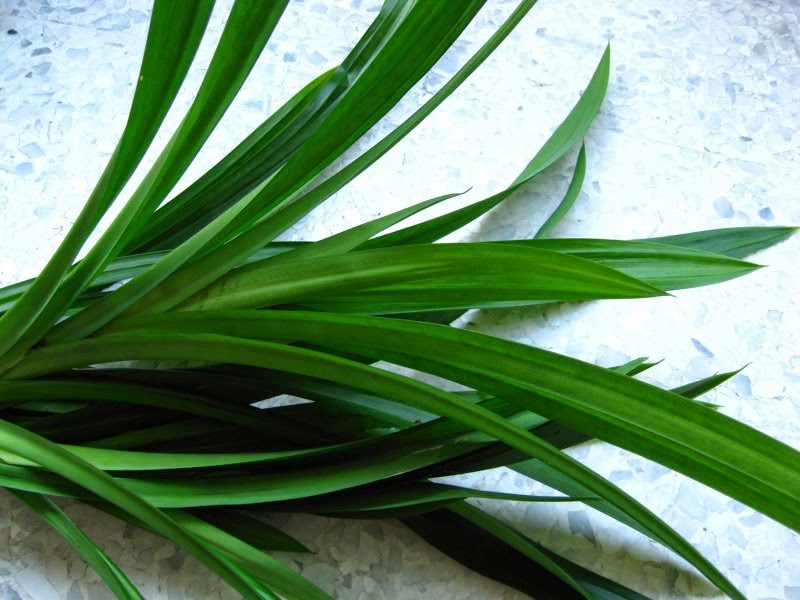 |
| Nasi Lemak |
Continuing on my Singapore Galore series is another one of my many favourite dishes I grew up loving, the hawker centre's darling, Nasi Lemak.
Did you know: Hawker Centres are open-air food courts in Singapore, Malaysia and Hong Kong with passionate vendors selling local inexpensive street food where patrons can eat al fresco. Hawker Centres are conveniently located near transportation hubs.
An iconic national dish from Malaysian, Nasi Lemak is relatively simple to make but involves a few key ingredients to ensure the presence of its authentic flavours. The main components include creamy rice steeped in coconut milk and knotted pandan leaves, crispy fried anchovies, rich eggs, refreshing cucumber slices, roasted peanuts and spicy chilli sauce.
 |
| Pandan Leaves |
Pandan leaves are indigenous to Southeast Asian cuisine and embodies a complex flavour profile that I find hard to describe. The tropical plants' long green leaves can be pounded into a paste, steeped in coconut milk or used as a wrapper to transfer its unique floral and nutty aromatic flavours to dishes.
 |
| Coconut pandan rice |
Did you know: Nasi Lemak means rich or creamy in Malay to represent the cooking process where the rice is steeped in coconut cream and steamed.
Like many national dishes, Nasi Lemak has been adopted and flavours improvised to suit taste buds from the Chinese adding more sweetness to the chilli paste to reduce the heat to Filipinos replacing the fried anchovies with crispy chicken.
There are so many reason why I love this dish, mainly for its tropical flavours that remind me of my childhood in Singapore and how easily I can replicate it at home! For those who haven't tried it, it's so simple and easy to whip up while its presentation is still impressive in all its delicious glory served up in a fragrant banana leaf!
 |
| Banana Leaves |
Did you know: Use banana leaves, easily found frozen in Asian grocery stores, to serve or even package your Nasi Lemak like how it's traditionally done. The leaves' oils impart a wonderful aromatic fragrance marrying all the yummy flavours while being an eco-friendly serving ware!
Nasi Lemak
Serves 2
Rice:
- 3/4 cup coconut milk
- 1/2 cup water
- 1/8 teaspoon ground ginger
- 1 (1/2 inch) piece fresh ginger, peeled and thinly sliced
- salt to taste
- 2 pandan (or screw pine) leaves, knotted
- 1/2 cup long grain rice, rinsed and drained
Toppings:
- 2 eggs, fried
- 2" cucumber, peeled & sliced
- 1/4 cup oil for frying
- 1 (4 ounce) package white anchovies, washed
- 1/2 cup raw peanuts
- 2 banana leaves, used as plates
Chilli Sauce:
- 1 tablespoon sunflower oil
- 1 small onion, diced
- 3 cloves garlic, minced
- 2 tablespoon chilli paste
- 1 (4 ounce) package white anchovies, washed
- 1 tsp white sugar
- 1 tsp lemon juice
Directions:
1) In a saucepan over medium heat stir in coconut milk, water, ginger, salt, pandan leaves and rice. Cover and bring to a boil. Reduce heat and simmer for 10-15 minutes until rice has absorbed milk and is fluffy. Remove the pandan leaves before serving.
 |
| Roasted peanuts |
2) In a large wok, heat 1 tbsp of sunflower oil over medium-high heat and stir in peanuts and cook briefly, until lightly browned, season with salt. Remove peanuts with a slotted spoon and place on paper towels to soak up excess grease.
3) Heat 1/4 cup of oil, add one package anchovies; cook briefly, turning, until crisp. Remove with a slotted spoon and place on paper towels. Discard oil. Wipe out skillet.
4) Heat 1 tbsp of oil in skillet and fry eggs. Sprinkle with salt & pepper. Place lid on top of skillet to cook eggs, 2 min.
 |
| Chilli Sauce |
5) Heat 2 tbsp oil in the skillet. Stir in the onion and garlic; cook until fragrant, about 1 or 2 minutes. Mix in the chilli paste, and cook for 2 minutes, stirring occasionally. Stir in salt, sugar, and lemon; simmer until sauce is thick, about 2 minutes.
6) Serve the warm rice on a banana leaf top with peanuts, fried anchovies, cucumbers and eggs with the chilli sauce on the side. So good, la! (Singlish)
 |
| So good la! |





















